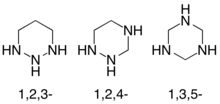| This article relies largely or entirely on a single source. Relevant discussion may be found on the talk page. Please help improve this article by introducing citations to additional sources. Find sources: "Triazinane" – news · newspapers · books · scholar · JSTOR (March 2020) |
 | |
| Identifiers | |
|---|---|
| CAS Number |
|
| 3D model (JSmol) |
|
| Beilstein Reference | 8477997 |
| ChEBI |
|
| ChemSpider | |
| PubChem CID | |
InChI
| |
SMILES
| |
| Properties | |
| Chemical formula | C3H9N3 |
| Molar mass | 87.126 g·mol |
| Except where otherwise noted, data are given for materials in their standard state (at 25 °C , 100 kPa). Infobox references | |
Triazinanes are a class of nitrogen-containing heterocycles. The parent molecules' molecular formula is (CH2)3(NH)3. They exist in three isomeric forms, 1,3,5-triazinanes being common. The triazinanes have six-membered cyclohexane-like ring but with three carbons replaced by nitrogens. Most commonly, the amines are tertiary.
See also
- 6-membered rings with one nitrogen atom: Piperidine
- 6-membered rings with two nitrogen atoms: Diazinane
- Triazine
- Borazine (borazole)
References
- Heterocyclic Chemistry T.L. Gilchrist 1985 ISBN 0-582-01421-2 (1997, ISBN 0-582-27843-0